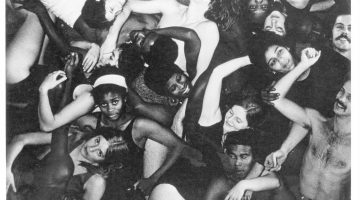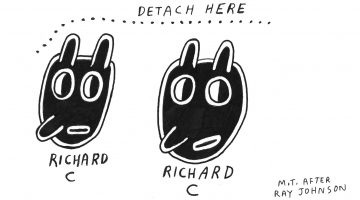Dr. Shoichi Hirai is a leading Gutai expert, currently a curator at the Museum of Modern Art, Kyoto, a position he assumed in October 2012. He was formerly with the National Art Center, Tokyo, where he organized the exhibition, “Gutai: Spirit of an Era,” which closed the day we conversed on September 10, 2012. Born in 1962, he earned his doctorate in modern and contemporary art from Kansai University Graduate School. Formerly a curator at the Hyogo Prefectural Museum of Art, Kobe, Dr. Hirai , curated the exhibitions, “Art in Kansai, 1950s-1970s” (1994), “Art After the Earthquake Disaster” (2001), and “Gutai, 1954-1972” (2004).” His publications include, “What’s Gutai?” (2004) and “Modernism in the Area Between Osaka and Kobe, 1900-1940.” He is a contributor to the catalog for the 2012 Los Angeles MOCA exhibition, “Destroy the Picture: Painting the Void, 1949-1962”, and the Guggenheim Museum, New York, exhibition, “Gutai: Splendid Playground”, to open in February 2013. Dr. Hirai will present a lecture open to the public at the San Francisco Art Institute on Thursday, February 21st, at 7:30 pm in conjunction with the Walter and McBean Galleries’ Gutai Exhibition, also opening early February.
Interview performed by SFAQ staff writer John Held, Jr. in Tokyo, 2012.
- Kazuo Shiraga. “ Please Come In” at “Experimental Outdoor Exhibition of Modern Art to Challenge the Midsummer Burning Sun. 1955. Photo courtesy the former members of the Gutai Art Association.
When did you begin as curator at the National Art Center?
Two thousand and six.
And before that you were at the Hyogo Prefecture Museum?
I was working for eighteen years in Kobe.
Is that when you developed your interest in Gutai?
When I was a university student I met a former member of the Gutai group, Mr. Yasuo Sumi. He’s a friend of Shozo Shimamoto.
I met Mr. Sumi.
Really?
He was introduced to me when I visited Japan in 1988. He became a member of AU –Artists Union, or Art Unidentified- I met him there… So, that was the beginning of your interest?
He told me the activity of the Gutai group. He introduced me to many persons.
Like who?
Mr. Shiraga. Of course, Mr. Shimamoto. Mr. Montonaga, and many of the members.

Jiro Yoshihara Work 1965 Oil on canvas 182 x 227 cm / 71 5/8 x 89 3/8 in © Shinichiro Yoshihara Private Collection Photo: Hidoto Nagatsuka
The old masters. (shared laughter) Did you write your thesis on Gutai while at University?
Yes, I wrote on Gutai and the Informel movement.
From University you went to the Museum?
As a curator in 1988.
There was a Gutai collection there?
Yes. I organized the exhibition of the Yamamura Collection in 1989, which included many Gutai objects. He was a collector of Gutai.
There weren’t many people interested in Gutai back then.
The Hyogo Museum bought his collection. I selected works and exhibited them.
Were they just the paintings, or also ‘Gutai’ magazine the postcards, the photographs?
Not that material. Just the paintings and many reproduced works.
The sculptures?
Yes. Next, I organized a big Gutai exhibition in 2004.
That was the same time as your book, “What’s Gutai” appeared. Was it associated with the show?
Yes, that’s right.
Very good book.
Thank you. It’s the first book on Gutai in Japan.

Shozo Shimamoto Untitled 1993 Enamel on canvas 237 x 170 x 3.8 cm / 93 1/4 x 66 7/8 x 1 1/2 in © Shozo Shimamoto Courtesy the artist and Hauser & Wirth Photo: Genevieve Hanson

Shozo Shimamoto Bottle Crash 1962 Glass and paint on canvas 162 x 130 cm / 63 3/4 x 51 1/8 in © Shozo Shimamoto Private Collection. Photo: Andrea Mardegan
Really? Fifty years after Gutai first appears. Unbelievable, the first book. Why?
I don’t know. Of course, there were many catalogs on Gutai, but not a book. So, no one could buy a book on Gutai in a bookstore.
Why the sudden interest in Gutai? Your show here in Tokyo, the upcoming Guggenheim exhibition, Ming Tiampo’s book, “Gutai: Decentralizing Modernism” appearing last year…why? Why Gutai?
It’s a difficult question. Because, I myself – I don’t know. (laughs).
Maybe its time has just come? Gutai was obviously an avant-garde movement ahead of its time. So, perhaps the general public is just catching up to it? Beginning to understand what they were doing in the 1950s.
When I was a university student, there was some kind of movement thinking of the Japanese avant-garde. There was a show of avant-garde art in Japan at the Pompidou Center [Paris, 1985]. But maybe – here comes another movement – thinking of Gutai’s activity.
Gutai seemed to be more accepted overseas than in Japan, and the exhibitions overseas made exhibitions in Japan possible. Do you think this is true?
Yes.
You had a panel discussion [“Reappraising Gutai Past and Present”] here at the museum in connection with your Gutai exhibition. Ming Tiampo was here. Who else?
Mr. Kawasaki [Koichi]. He was the curator of the Ashiya City Museum of Art and History. And Mr. Yurugi [Yasuhiro], he was curator of the Tokyo Metropolitan Museum. He was the first curator who discovered Gutai – in the early 1980s. And Mr. Mattijs Visser. He organized exhibitions on Gutai and the Zero Group in the last years.
The Japanese Zero group?
No. The Dutch group.
Nul. Because there was a Zero group before that in Japan.
(laughs) Zero-kai.

Saburo Murakami Work 1963 Paint, polyvinyl acetate adhesive, plaster on board 182.5 x 107 x 10 cm / 71 7/8 x 42 1/8 x 3 7/8 in © Makiko Murakami Courtesy Saburo Murakami. Photo: Keizo Kobashi

Saburo Murakami. “At One Moment Opening Six Holes” at “1st Gutai Art Exhibition,” Tokyo, 1955. Photo courtesy the former members of the Gutai Art Association.
Shiraga, Murakami, Kanayama, Tanaka [of Zero-kai] later became Gutai members…In your book, “What’s Gutai,” you make mention of the Sanka group, who were doing performance and installation works in the 1920s. I’ve heard nothing of them.
The Sanka group was influenced by Dada and Futurism. They began performance – like futurist…
…theater.
They performed at theaters in Tokyo, Kyoto and Kobe. So, there is no evidence that Mr. Yoshihara saw the performance, but maybe he heard of it, because there are many friends of his influenced by Dadaism and Futurism.
What about Mr. Tapié, who had such a big influence on Gutai’s acceptance abroad?
It’s very important. Mr. Tapié introduced their activity to Europe and America. But in exchange for it, they became a painting group.
And complicated. Many people, like Ben Vautier, say that Tapié was a negative influence. But many people came to the Pinatheca and were positively influenced – Cage, Cunningham, Rauschenberg, Jasper Johns. When was Johns there?
In 1964.
And Clement Greenberg was there?
He came in 1966.
Paul Jenkins the abstract expressionist painter stayed for a whole month. He was with the Martha Jackson Gallery [where Gutai exhibited in 1958].
Yes. On the second floor. (laughs).
One other thing about early Gutai I wondered about was the influence of Ray Johnson and Mail Art on Gutai.
Maybe he saw the magazine [Gutai]. I think that the members knew expression method called Mail Art from him.

Atsuko Tanaka Untitled 1956 Gouache and crayon on paper 54.5 x 77 cm / 21 1/2 x 30 3/8 in © Ryoji Ito Private Colllection. Photo: Michael Bodycomb
How difficult was [Jiro] Yoshihara with the members?
In the early years, they had a strong relationship, but as members increased and the group grew bigger, it weakened.
In 1971, after “Expo 1970,” early members like Shimamoto and Shiraga departed? Why?
Shiraga stayed, but Mr. Murakami, Shimamoto and Motonaga left. I heard there was a complicated problem at Expo 1970 about financial problems.
When Yoshihara died, the group broke up. Shozo Shimamoto began the AU group. Do you see that as related to Gutai in any way?
No. Gutai was a very special group with a big leader – Mr. Yoshihara. It was an extraordinary group in Japan.
I had a question about the Life magazine, “One Day Outdoor Art Exhibition.”
In 1956.
Such a beautiful photograph of Yoshihara in the boat in the water tank. But those ‘Life’ photographs were never published and presumed lost. Have they ever been seen?
No. I’ve tried to see them. I wrote to the photographer’s wife – Mr. [John] Launois wife. She’s Japanese.
Did you try ‘Life’ magazine?
Yes, of course.
It’s a tragedy, but fortunately Gutai members documented the event… Is your exhibition here going to travel?
No. Only Tokyo.
Are there any other Gutai events planned in Japan.
No. I don’t think so.
Are you looking forward to the Guggenheim show next February?
Yes.
Will you go to New York?
Yes. I wrote a text for the catalog.
What is it on?
Gutai and Pre-War Modernism in the Kansai area.
There are so many great Gutai images. It’s fortunate that Yoshihara could afford cameras.
And also Mr. Yoshida, Mr. Shiraga and Mr. Montonaga had cameras. They took many photos.
Do you have a favorite Gutai image?
(laughs) It’s very difficult. Gutai has many aspects. Action. Environment. Installation and technology. So it’s hard to choose just one image.
Right. There are so many good ones. Does anyone have a full set of ‘Gutai’ magazines? They are very rare.
Even in Japan.
In Japan. Really? Is there a full set somewhere?
Hyogo [Prefectural Museum] has them.
What about the Tokyo Metropolitan Museum?
Yes. They are some of the few museums to have them.
It was very important that they were reprinted. Whose idea was that?
(laughs). Me.
Thank you! (shared laughter) But it must have been very expensive to do?
Yes.
But it was very expensive to buy, too. (shared laughter) It is so important to have that. It is really well done. A book I haven’t seen is “Document Gutai: 1954-1972.” Maybe you can show it to me?
It’s a very good book. It was also done by the Ashiya City Museum of Art and History.
Are there many collectors of Gutai in Japan? There must be collectors of Post-War Japanese Modern Art, and this is an important aspect of that.
No, there are few collectors of Gutai like the late Mr. Yamamura in Japan. And we have no archives about Gutai in Japan.
Really!
It’s a very serious problem for Gutai researchers.
So, there’s still a lot of work to be done.
Yeah, yeah, yeah.
Well, thank you for making such a good start. (shared laughter) Arigatou gozaimasu.

Kazuo Shiraga painting with his feet for Life magazine at the Nishinomiya factory of Jiro Yoshihara, 1956. Photo courtesy the former members of the Gutai Art Association.





